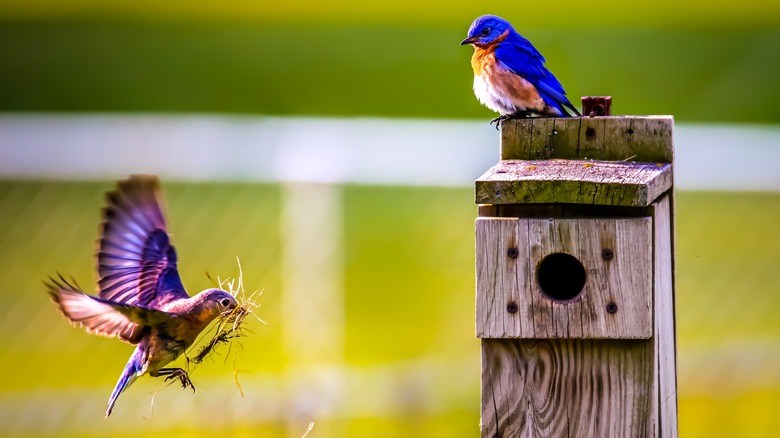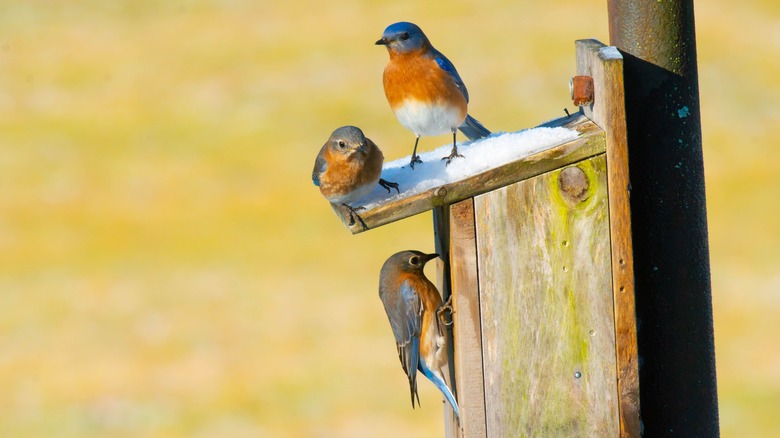Keep These Feather-Friendly Tips In Mind When DIYing A Wooden Birdhouse
Woodworkers aren't always experts in the things they're making; they're experts in making the things. But, TikTok woodworker Leah Houghtaling (@leahhoughtalingww) knows her stuff, and in this case, her stuff is making a birdhouse that actually works for the birds. In her video, and with her usual humor and charm, Houghtaling manages to touch on most of the keys to building a really good bird nesting box, starting with making sure you choose a plan that's suitable for the birds you want to attract.
Houghtaling's birdhouse, she says, is best "for smaller birds — chickadees, wrens, sparrows, titmice." By identifying the species first, you're simplifying some later decisions like the dimensions, hole size, location, and hanging height of your nesting box. For picking a birdhouse design, we like NestWatch's plan finder, which lets you look up plans by region and habitat. It also highlights birds whose populations are in decline.
Do your homework before you finalize the nest box's location. Some species will benefit more from a habitat that includes water and the right foods. For example, though it's a common mistake everyone makes when trying to attract cardinals to their yards, cardinals will be more attracted to the right berries and seeds than to a nest box. Once you've determined what type of birds you'd like to attract, it's important the ensure the box you are building is safe for your feathered friends.
Building the nest box right
Review your birdhouse plan to make sure it works with the following tips. You can adapt the plan if necessary before you start building. Starting with the materials, you'll usually want to use untreated wood that's at least ¾ inch thick. Use galvanized screws to minimize corrosion, and make sure the screws aren't too long or they'll protrude through the boards and might injure the birds. The floor should be recessed (that is, positioned above the bottom of the walls) ¼ inch and should provide drainage to remove any water that finds its way into the box. Houghtaling's design has a gap all the way around the floor; other plans simply cut holes in the floor's corners to let the water out.
Birdhouses shouldn't have perches, which are more useful to predators than to the birds, but they should have ventilation holes along the tops of the sidewalls. These ventilation holes should mostly be protected from rain by a sloped roof that overhangs the walls by at least 2 inches on all sides and 2 to 4 inches on the side with the entrance hole. Houghtaling, whose small home in New York apparently doesn't have useful overhangs, is hilariously insistent on this point. Cutting ¼-inch-deep channels the width of your sawblade into the bottom of these overhangs will help route water away from the nest box. And, don't forget to score the interior walls with a saw blade or scratch awl to help birds climb out of the birdhouse.
Other considerations for a safe, cozy nest box
Not every bird wants to live 3 feet outside your kitchen window. Nest box placement is key to attracting the right birds to your nest boxes, and it's important to get the height, habitat, spacing between boxes, and other details right. You can look up common species' requirements at NestWatch. In general, you'll want to stay clear of areas where herbicides and pesticides are used.
It's often best to mount your birdhouse to a smooth metal or PVC pole, which can be difficult for predators to navigate. Poles also simplify attaching guards to protect against raccoons, cats, rodents, and other predators. A predator guard like a stovepipe baffle or cone-shaped collar can make it difficult for predators to reach the birdhouse. Another deterrent would be to build a hardware cloth tunnel at the opening, which birds can easily cope with but most predators cannot.
While your goal in all of this is to make a nest box that works for birds, you can make things easier on yourself, as well. Extend the back of the box well above and below the box itself to make it easier to attach. Adding a hinge to the roof or one of the walls will make cleaning out the box easier. Houghtaling makes the floor of hers removable, which is a smart approach. And, consider outfitting your DIY birdhouse with a camera so you can enjoy the goings-on from a distance that's comfortable for the birds.

